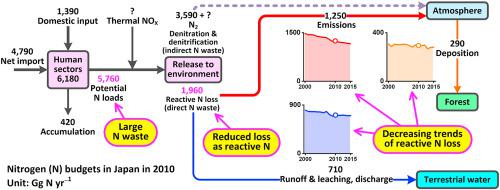Environmental Pollution ( IF 7.6 ) Pub Date : 2021-06-09 , DOI: 10.1016/j.envpol.2021.117559 Kentaro Hayashi 1 , Hideaki Shibata 2 , Azusa Oita 3 , Kazuya Nishina 4 , Akihiko Ito 4 , Kiwamu Katagiri 5 , Junko Shindo 6 , Wilfried Winiwarter 7

|
The benefits of the artificial fixation of reactive nitrogen (Nr, nitrogen [N] compounds other than dinitrogen), in the form of N fertilizers and materials are huge, while at the same time posing substantial threats to human and ecosystem health by the release of Nr to the environment. To achieve sustainable N use, Nr loss to the environment must be reduced. An N-budget approach at the national level would allow us to fully grasp the whole picture of Nr loss to the environment through the quantification of important N flows in the country. In this study, the N budgets in Japan were estimated from 2000 to 2015 using available statistics, datasets, and literature. The net N inflow to Japanese human sectors in 2010 was 6180 Gg N yr−1 in total. With 420 Gg N yr−1 accumulating in human settlements, 5760 Gg N yr−1 was released from the human sector, of which 1960 Gg N yr−1 was lost to the environment as Nr (64% to air and 36% to waters), and the remainder assumed as dinitrogen. Nr loss decreased in both atmospheric emissions and loss to terrestrial water over time. The distinct reduction in the atmospheric emissions of nitrogen oxides from transportation, at −4.3% yr−1, was attributed to both emission controls and a decrease in energy consumption. Reductions in runoff and leaching from land as well as the discharge of treated water were found, at −1.0% yr−1 for both. The aging of Japan's population coincided with the reductions in the per capita supply and consumption of food and energy. Future challenges for Japan lie in further reducing N waste and adapting its N flows in international trade to adopt more sustainable options considering the reduced demand due to the aging population.
中文翻译:

2000 年至 2015 年日本的氮预算:环境中氮损失的减少趋势和进一步减少氮浪费的挑战
以氮肥和材料的形式人工固定活性氮(Nr、氮 [N] 化合物而非二氮)的好处是巨大的,同时通过释放Nr 对环境。为了实现可持续的氮利用,必须减少氮对环境的损失。国家层面的 N 预算方法将使我们能够通过量化该国重要的 N 流量来全面掌握 Nr 对环境的损失情况。在本研究中,使用可用的统计数据、数据集和文献估算了日本 2000 年至 2015 年的 N 预算。2010 年日本人类部门的净氮流入总量为 6180 Gg N yr -1。420 Gg N yr -1在人类住区积累,5760 Gg N yr -1从人类部门释放,其中 1960 Gg N yr -1作为 Nr 损失到环境中(64% 到空气中,36% 到水),其余假设为二氮。随着时间的推移,大气排放中的 Nr 损失和陆地水的损失均有所减少。运输中氮氧化物的大气排放量显着减少,为 -4.3% yr -1,这归因于排放控制和能源消耗的减少。发现地表径流和浸出以及处理过的水的排放量减少了 -1.0% yr -1对彼此而言。日本人口老龄化与人均食品和能源供应和消费的减少相吻合。考虑到人口老龄化导致需求减少,日本未来面临的挑战在于进一步减少氮废物并调整其在国际贸易中的氮流动以采用更可持续的选择。











































 京公网安备 11010802027423号
京公网安备 11010802027423号